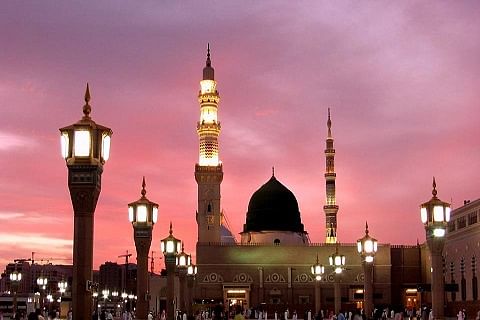The society of Arabia was beset with vice, superstitions and barbarism. Social inequality, persecution, drinking, gambling, deceit, plundering and other heinous vices were rampant. The moral and material conditions were deplorable. Position of women was worse, tribal rivalry was the dominant feature of Arab clans.
Abdul Muttalib was generous and fair which won him the highest position in the Quraish who recognised him as their elder leader. He had several sons and daughters. He took his youngest son Abdullah to the chief of the Banu Zohra clan and there he gave his son in marriage to Aminah, the daughter of Wahhab. Aminah gave birth to a son on Monday, the 12 Rabi ul Awwal, 570 CE. The child was named Muhammad (Salla Allahu Alayhi Wa Sallam) by his grandfather and Ahmad by his mother.
When the whole world was reeling under oppression and injustice, he came to this earth as saviour of oppressed humanity.
Within a short period of twenty years, he transformed the barbarous Arabians into a civilised nation and lifted up his people from the abyss of moral and spiritual degradation to high conception of morality and of justice.
He banished all tribal factions and brought the whole of Arabia into one homogenous unity. Friends and foes, Muslims and non-Muslims were alike to him and in the eye of his law. Justice, equality and truth were his motto.
The prophet (Salla Allahu Alayhi Wa Sallam) was a great social reformer. He tried to reconcile the followers of rival creeds, he established an empire upon good will and cooperation of all sections of people.
The charter which he framed at al-Madinaah granted the security of life, property, dignity. He was the one who brought a permanent peace between all conflicting religions, races and regions.
The Arab Peninsula was divided into several tribes which always fought with each other even on trifles. When disorder and unrest were the order of day Prophet Muhammad (Salla Allahu Alayhi Wa Sallam) came with clear message and guidance to bring them on the right track of righteousness.
The Prophet wiped out age long vices from the soil of Arabia. The removal of social inequality was the most important and far-reaching consequence.
He could not find any reason for any distinction between man and women on account of mere accident of birth in a particular family or country. He broke down all artificial barriers which society had set up to fortify privileges of wealth, work or colour.
All human beings he declared were equal and the highest rank was his who was the most obedient to Allah and most useful to mankind. The essence of a good man was righteousness. He established a worldwide brotherhood which welded high and low, rich and poor, white and black into one fraternity.
He abolished slavery which had been in vague among the Arabs. Prophet (peace be upon him) declared that there was no service more acceptable to God than the emancipation of slaves. The prophet uplifted the economic conditions of the poor and prohibited the usury to stabilise the economic conditions of the poor.
He introduced the system of Zakat, Sadaqah in society. Poor, widows and orphans received due social and economic support and security. He took delight in forgiving and inspired followers to forgive and show mercy even to his arch enemies.
Modesty and kindness, patience and generosity pervaded his conduct and riveted the affections of all around him. With the bereaved and afflicted he sympathised tenderly. He shared his food even in times of scarcity with others and was eager to see the comfort of everyone around him. He was most humane to servants.
The Prophet is the role model for humanity. He was a devoted husband, an affectionate father, and a sincere friend. He was a successful businessman, honest and trustworthy with impeccable integrity, a far-sighted reformer, efficient administrator, impartial judge, and a great statesman who touched all the spheres of life.
The Prophet fell ill in the 11th year of Hijrah and on the fifth day of his illness he went to the house of A’ishah where he breathed his last and was buried there.
DISCLAIMER: The views and opinions expressed in this article are the personal opinions of the author.
The facts, analysis, assumptions and perspective appearing in the article do not reflect the views of GK.






